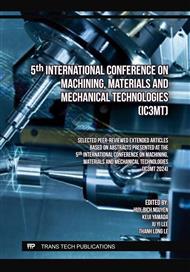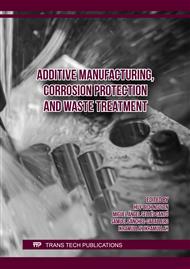p.3
p.13
p.21
p.31
p.39
p.47
p.59
p.65
Influence of Axis Configuration in 5-Axis Control Machining Center on Geometric Error of Cubic Machined Surfaces
Abstract:
Cubic-machining is proposed as a new accuracy evaluation method for 5-axis machining centers. The cutting tool posture, toolpath and workpiece size in each zone are being studied. In this study, cubic-machining on two types of vertical type 5-axis machining centers with different rotational table configurations is simulated to evaluate the effect of structure errors between each axis on the machined surface. The B-axis rotational table configuration is defined as W/CBY0XZ/T for both models. The simulation results on the top surface of cube show that the effect of structure error between the B-Y axes on the tilting table model with tilted B-axis appeared than that on the trunnion table model as machining error. In the tilting table model, the positions of the B-axis coordinate system and the workpiece coordinate system are far apart in the Y and Z directions due to the inclination of the B-axis. Therefore, the structure error between the B-Y-axes acts in the direction of shifting the table up and down, resulting in larger machining errors. On the other hand, the superposition of structure errors except between the B-Y axes is common to both models, and it is confirmed that a similar evaluation could be made by taking the difference between the reference surface and the other surfaces. However, the eight machined surfaces except the reference surface have a tool posture symmetrical to the C-axis, making it impossible to compare the height differences between these surfaces. On the side surface of cube, the tool posture with a large change in the B-axis control value resulted in significant height differences between the respective machined surfaces. It is confirmed that tool postures with varying B-axis control values can lead to the identification of structure errors.
Info:
Periodical:
Pages:
31-38
Citation:
Online since:
March 2025
Authors:
Price:
Сopyright:
© 2025 Trans Tech Publications Ltd. All Rights Reserved
Share:
Citation:



